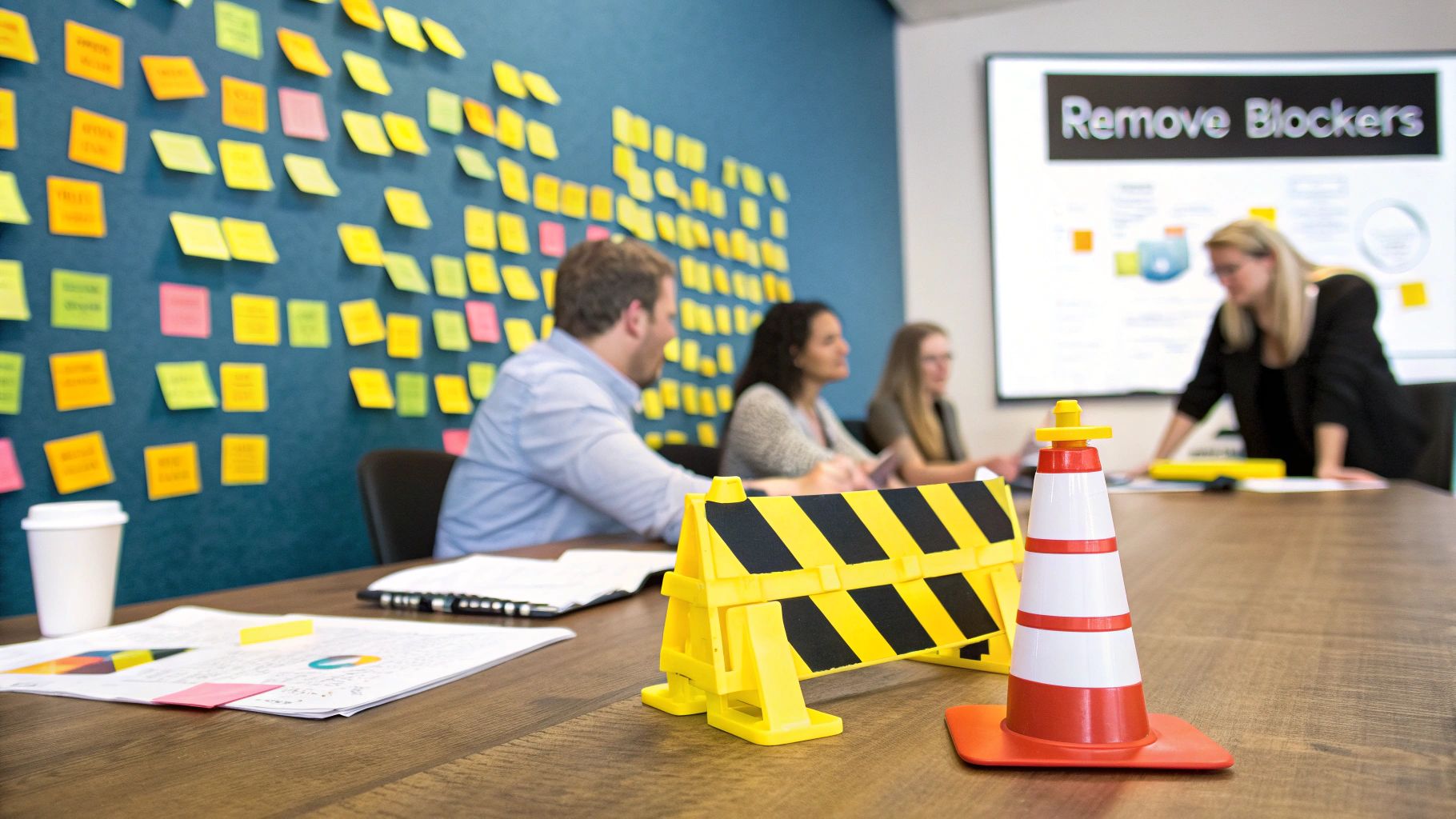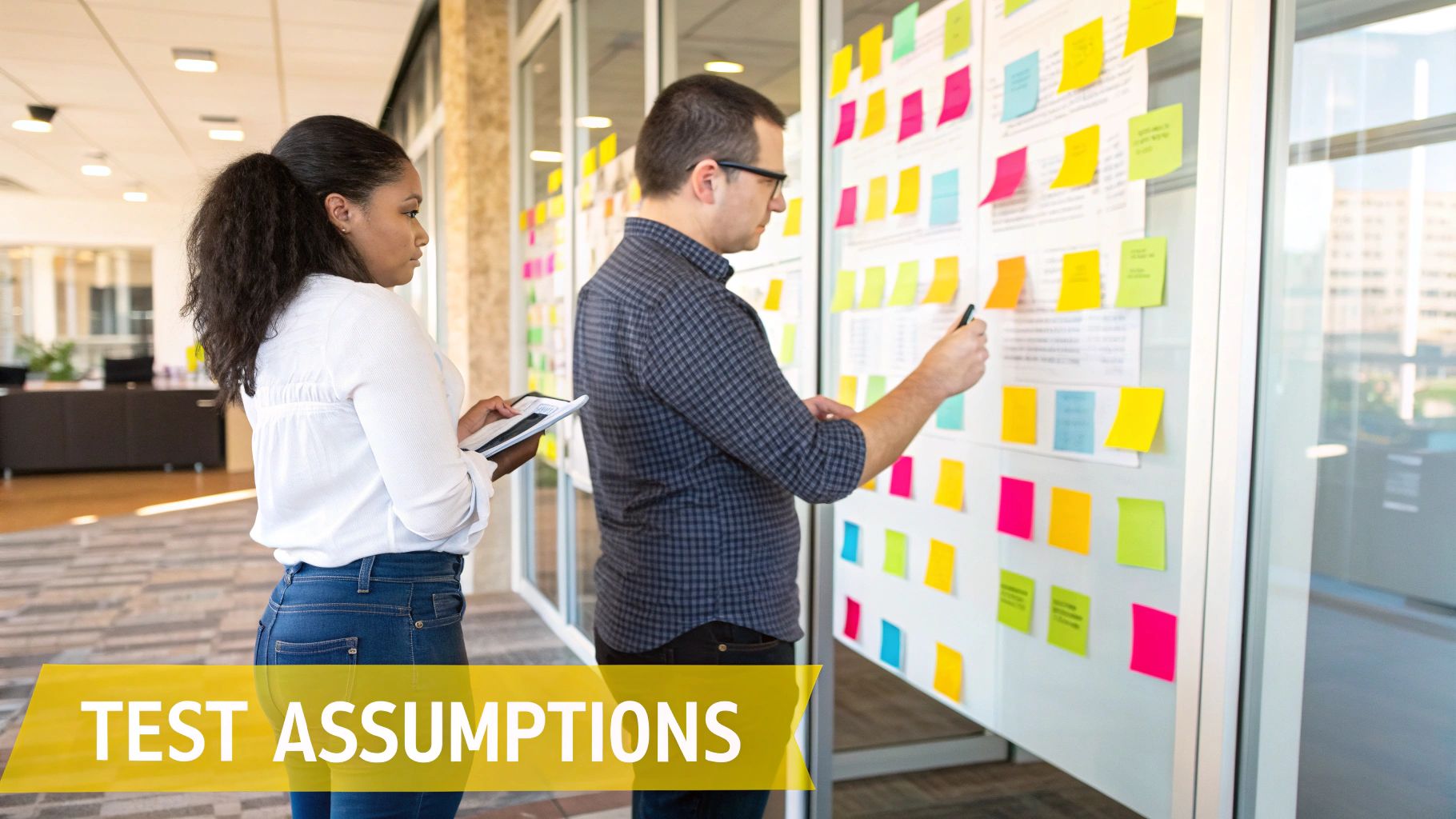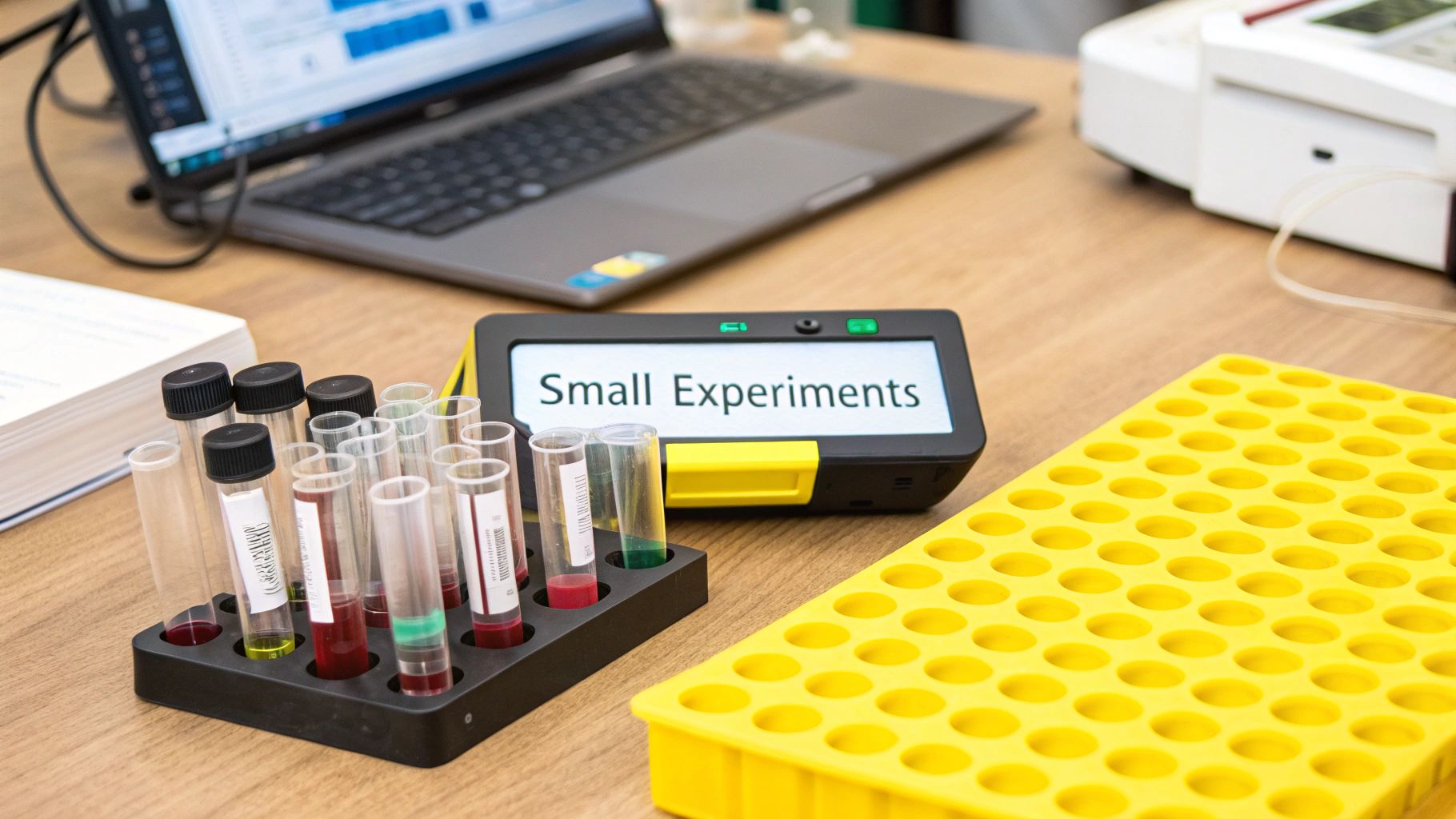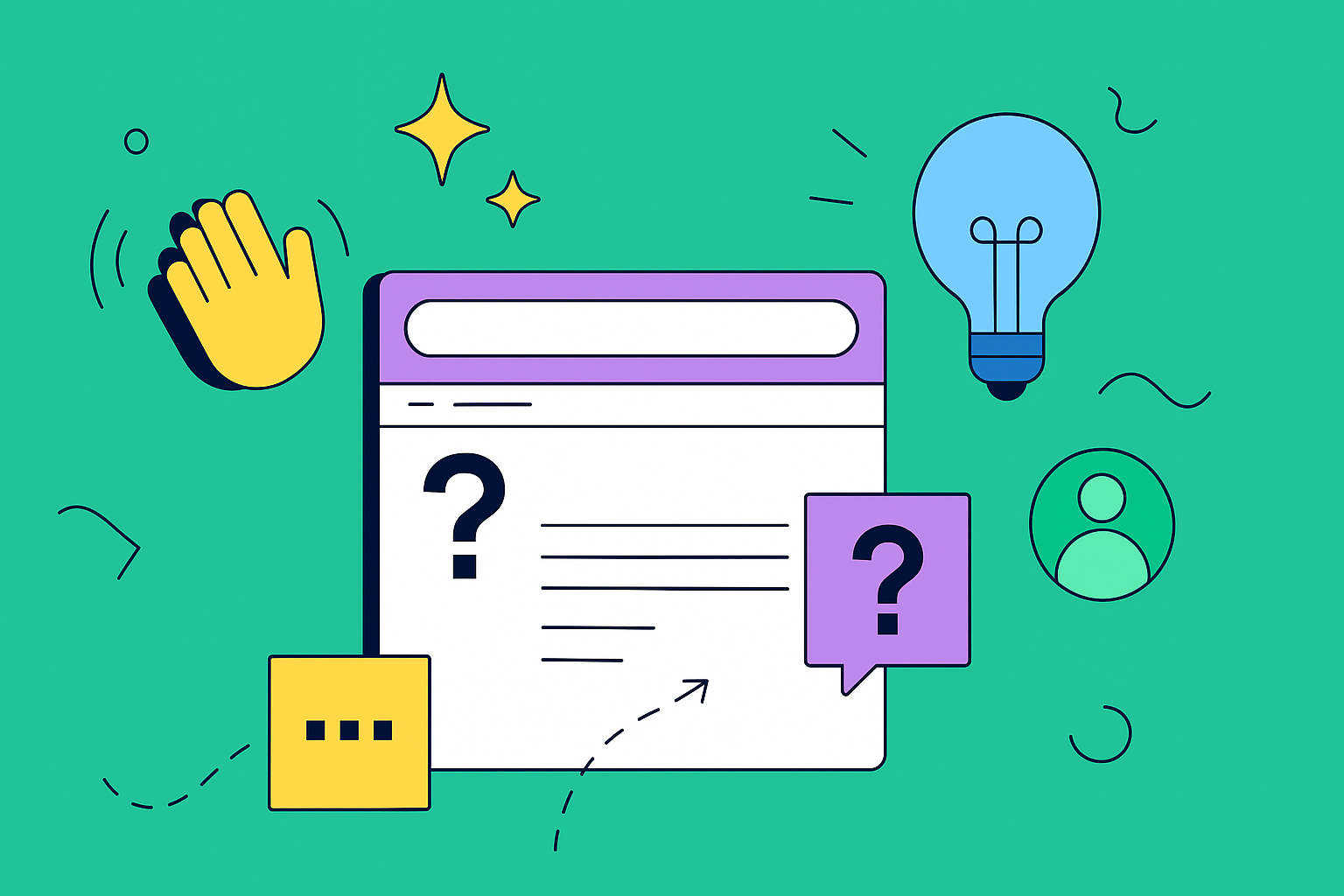In the world of agile development, momentum is everything. But what happens when progress stalls, communication breaks down, or teams fall into a routine of simply going through the motions? The difference between a team that just survives and one that truly thrives often comes down to the quality of its conversations. A skilled agile coach or Scrum Master knows that telling a team what to do is far less powerful than asking a question that helps them discover the answer themselves.
These questions are not just prompts; they are catalysts for reflection, critical thinking, and collaborative problem-solving. This article provides a curated list of powerful agile coaching questions, each designed to address specific challenges and unlock new levels of performance. We’ll break down the strategy behind each question, offer tactical advice on when and how to deploy it, and provide actionable takeaways to transform your team meetings from mere status updates into engines of continuous improvement.
You will learn how to use targeted questions to diagnose hidden issues, challenge assumptions, and refocus your team on delivering value. Get ready to move beyond surface-level discussions and start facilitating conversations that create real, lasting change.
1. What is preventing us from moving faster?
This question is a cornerstone of agile coaching, acting as a direct probe into a team’s efficiency and a catalyst for continuous improvement. It cuts through superficial status updates to uncover the systemic issues, hidden blockers, and process friction that hinder progress. By asking this, you shift the team’s focus from simply doing the work to optimizing how the work gets done, fostering a proactive problem-solving mindset.

Popularized by agile pioneers like Henrik Kniberg (Spotify) and Lyssa Adkins, this question is powerful because it’s open-ended yet laser-focused on value delivery. It invites honest reflection on everything from technical debt and slow deployment pipelines to unclear requirements and external dependencies.
Strategic Application
Use this question during key ceremonies like retrospectives or even daily stand-ups when the team feels stuck or velocity has plateaued. It’s less about blaming individuals and more about inspecting the system.
Key Insight: This question frames “speed” not as rushing, but as the smooth, unimpeded flow of value. It encourages a systems-thinking approach, where the team analyzes the entire delivery process rather than just isolated tasks.
For example, a team at Netflix might use a variation of this to dissect their deployment pipeline, identifying bottlenecks that delay getting code to production. Similarly, Spotify squads famously use it to surface organizational impediments that require escalation beyond the team’s direct control.
Actionable Takeaways
To make this one of your most effective agile coaching questions, implement these tactics:
- Dig Deeper with 5 Whys: When an impediment is named, don’t stop there. Apply the 5 Whys technique to drill down to the root cause. A “slow code review” might actually stem from a lack of shared coding standards.
- Categorize and Visualize: Group impediments into two buckets: those the team can solve and those requiring outside help (organizational). Create a visible impediment backlog (on a physical board or digital tool) to track them.
- Focus and Execute: Resist the urge to tackle everything at once. Have the team vote on the top 1-2 impediments that, if solved, would have the biggest impact. This prevents analysis paralysis and builds momentum.
Improving how your team addresses these impediments is crucial. For a deeper dive into methods that can help, explore these effective team collaboration strategies.
2. What did we learn about our assumptions?
This question shifts a team from a feature-factory mindset to a learning-oriented one, placing empirical evidence at the heart of product development. It challenges the team to treat their plans and requirements not as facts, but as hypotheses to be tested. By asking this, an agile coach fosters a culture of intellectual honesty and data-informed decision-making.

Popularized by thought leaders like Jeff Patton and Gojko Adzic, this question is powerful because it directly connects a team’s work to outcomes. It forces a reflection on what was believed to be true versus what was discovered, revealing critical insights about users, the market, or the technology itself.
Strategic Application
Use this question during sprint reviews and retrospectives to evaluate the “why” behind the work completed. It’s especially potent when a feature doesn’t deliver the expected results or when the team is navigating high uncertainty. The goal is to make learning an explicit and valued part of the process.
Key Insight: This question frames “failed” experiments not as mistakes, but as valuable learning opportunities. It transforms the conversation from “Did we build it right?” to “Did we build the right thing, and what does the evidence tell us?”
For instance, Amazon’s “Working Backwards” process inherently relies on validating assumptions laid out in the initial press release document. Similarly, Spotify squads constantly test hypotheses about user engagement with new features, using the learnings to pivot or persevere. This is one of the most effective agile coaching questions for building a truly empirical culture.
Actionable Takeaways
To make this question a driver of continuous learning, use these tactics:
- Map Assumptions Early: At the start of an initiative or sprint, use techniques like Assumption Mapping to explicitly state and prioritize the riskiest assumptions. This makes them visible and testable.
- Celebrate Learning, Not Just Success: Create a safe environment where disproving an assumption is seen as a victory. Acknowledge and reward the team for invalidating a bad idea before it consumes significant resources.
- Connect Learning to the Backlog: Ensure the insights gained are not lost. Translate new learnings into concrete actions, such as creating new user stories, updating existing ones, or changing the priority of upcoming work.
Embedding this reflective practice is key to team growth. For more ways to facilitate these discussions, review these powerful retrospective facilitation techniques.
3. How might we experiment to validate this?
This powerful question pivots a team from solution-first thinking to an evidence-based, experimental mindset. It challenges the assumption that we know the right answer and instead promotes a culture of learning through small, fast, and safe-to-fail tests. By asking this, an agile coach encourages the team to de-risk big ideas and gather real data before committing to significant development effort, embodying the core principles of lean-agile development.

Popularized by pioneers like Eric Ries in The Lean Startup and design firm IDEO, this question is the heartbeat of hypothesis-driven development. It moves the conversation from “We should build X” to “We believe building X will achieve Y; how can we test that belief with the least possible effort?” This approach is fundamental to how tech giants innovate and avoid costly mistakes.
Strategic Application
Use this question during product backlog refinement, sprint planning, or any discovery session where a new feature or significant change is proposed. It is most effective when a proposed solution is based on assumptions rather than concrete user data, or when the cost of building the full feature is high.
Key Insight: This question frames product development not as a feature factory but as a scientific process. The goal shifts from delivering code to delivering validated learning, ensuring that every development cycle contributes directly to business outcomes.
For example, Booking.com runs thousands of A/B tests annually, treating every change as a hypothesis to be validated by user behavior. Similarly, Etsy’s continuous experimentation platform empowers teams to test hundreds of ideas simultaneously, allowing data, not opinions, to guide their product roadmap.
Actionable Takeaways
To make “How might we experiment to validate this?” one of your most impactful agile coaching questions, try these tactics:
- Define Success First: Before running any experiment, collaboratively define what success and failure look like. Use clear, measurable metrics (e.g., “a 5% increase in sign-ups from the test group”).
- Start with the Smallest Possible Experiment: Challenge the team to devise the absolute simplest test to validate their core assumption. This could be a landing page to gauge interest, a manual “concierge” test, or a simple prototype.
- Time-box Experiments: Assign a fixed duration for each experiment to maintain momentum and create a sense of urgency. This prevents tests from dragging on and forces a clear decision point: pivot, persevere, or abandon.
4. What would our customers say about this?
This powerful question forces a team to break out of its internal bubble and adopt the most critical perspective of all: the customer’s. It serves as a constant reality check, ensuring that every decision, feature, and technical choice is anchored in real-world user value. Asking this question shifts the focus from “Can we build this?” to “Should we build this?” and “How will this truly benefit the person using our product?”

Popularized by customer-centric leaders like Jeff Bezos (Amazon) and product thought leaders like Marty Cagan, this question is the heartbeat of a value-driven organization. It challenges assumptions, combats internal biases, and ensures the team’s effort directly translates into a better customer experience, which is a cornerstone of agile philosophy.
Strategic Application
Integrate this question into backlog refinement, sprint planning, and sprint reviews. It’s particularly effective when teams are debating technical implementation details, prioritizing features, or defining acceptance criteria. It moves the conversation from personal opinions to a shared goal of customer satisfaction.
Key Insight: This question is not about guessing. It’s about cultivating deep customer empathy so that the team can make informed hypotheses about customer reactions, which are then validated through feedback loops. It transforms the customer from an abstract concept into an active participant in the development process.
For instance, at Amazon, the “customer obsession” principle means teams are expected to start with the customer and work backward, often writing a press release for a product before any code is written. At Airbnb, this question guides decisions to ensure features align with their mission of helping guests “Belong Anywhere,” focusing on user trust and community.
Actionable Takeaways
To make this one of your most effective agile coaching questions, implement these tactics:
- Develop and Use Personas: Create detailed customer personas based on real user research. During discussions, ask, “What would ‘Marketing Mary’ or ‘Developer Dave’ say about this feature?” This makes the customer tangible and relatable.
- Bring the Customer’s Voice into Ceremonies: Regularly share direct customer feedback, support tickets, or user interview clips during team meetings. Hearing the customer’s own words is far more impactful than a summary.
- Invite Customers to Sprint Reviews: The ultimate way to answer this question is to ask the customer directly. Inviting them to sprint reviews provides immediate, unfiltered feedback and closes the loop between development and user value.
Embedding this customer-centric view is fundamental to building products people love. For a deeper understanding of how to connect team activities to user needs, consider exploring frameworks for continuous discovery habits.
5. What is the smallest thing we could deliver that would provide value?
This question is a powerful tool for instilling the agile principle of incremental value delivery. It forces a team to pivot from thinking about large, monolithic features to identifying the absolute smallest slice of functionality that can be shipped to a user to generate feedback or learning. By asking this, an agile coach helps the team combat scope creep and focus on what truly matters: delivering a continuous flow of value.
This concept was championed by pioneers like Kent Beck (Extreme Programming) and Ron Jeffries (Agile Manifesto signatory). It is the essence of building momentum and validating assumptions quickly. It challenges the team to break down complexity into manageable, shippable increments, which is fundamental to modern product development.
Strategic Application
Use this question during backlog refinement, sprint planning, or any time a user story feels too large or abstract. It’s particularly effective when a team is overwhelmed by a complex epic or struggling to define a clear starting point. This question shifts the conversation from “how do we build everything?” to “what is the first step that proves our hypothesis?”
Key Insight: This question redefines “done” not as the completion of a massive feature, but as the delivery of a small, valuable, end-to-end user experience. It prioritizes learning and feedback over comprehensive, but un-validated, functionality.
For example, Facebook’s “Move Fast” philosophy encourages shipping small, incremental updates continuously. Similarly, Spotify often releases new features to a small segment of users first to gather data, embodying the principle of delivering the smallest valuable change to learn from it.
Actionable Takeaways
To make this one of your go-to agile coaching questions, implement these tactics:
- Practice Story Slicing: Use techniques like the “Hamburger Method” or “Workflow Steps” to break down user stories. The goal is to find a thin, vertical slice that goes through all layers of the tech stack and delivers something tangible to the user.
- Focus on the Core Value: Before discussing features, ask the team to articulate the single most important problem the user story is trying to solve. Then, challenge them to build only what is necessary to solve that one problem.
- Use Progressive Disclosure: For complex features, deliver the core functionality first and hide more advanced options. Reveal complexity progressively as users become more familiar with the feature, based on feedback and usage data.
Mastering how to break down work into small, valuable pieces is a critical skill. For more guidance on structuring this work, discover these 8 essential sprint planning tips.
6. How are we measuring success?
This question forces a team to look beyond “being busy” and confront whether their effort is creating tangible value. It shifts the conversation from outputs (e.g., lines of code, features shipped) to outcomes (e.g., increased user engagement, reduced customer churn). By asking this, an agile coach helps the team connect its daily work directly to business objectives and customer satisfaction, ensuring alignment and purpose.
Popularized by thought leaders like John Doerr with his OKR (Objectives and Key Results) framework and Marty Cagan’s focus on outcome-based product management, this question is fundamental to building high-performing, value-driven teams. It challenges the “feature factory” mindset and promotes a culture of accountability for results.
Strategic Application
Use this question during sprint planning, product backlog refinement, or quarterly reviews to ensure the team’s goals are clear, measurable, and aligned with stakeholder expectations. It’s particularly powerful when a team seems to be working hard but isn’t making a noticeable impact on key business metrics.
Key Insight: This question reveals whether a team has a shared definition of “done” that includes actual value delivery. It separates activity from achievement, pushing the team to define and track metrics that prove their work matters.
For example, Google famously uses the OKR system to cascade measurable outcomes from the company level down to individual teams, ensuring everyone is pulling in the same direction. Similarly, LinkedIn’s product teams move beyond simply launching features; they measure success through specific engagement and retention metrics, iterating until those metrics improve.
Actionable Takeaways
To make this one of your most effective agile coaching questions, implement these tactics:
- Combine Leading and Lagging Indicators: Track lagging indicators like revenue or customer satisfaction, but also use leading indicators like daily active users or feature adoption rates to get early feedback on your trajectory.
- Focus on Outcomes Over Outputs: Instead of celebrating “10 user stories completed,” celebrate “a 15% reduction in user onboarding time.” Frame success in terms of the customer or business impact.
- Make Metrics Visible and Accessible: Create a team dashboard (digital or physical) that displays key success metrics. This constant visibility keeps the team focused on what truly matters and encourages data-informed decisions. While customer-facing metrics are vital, understanding internal health is also key; learn more about measuring team morale.
- Regularly Review and Adapt: Success metrics aren’t set in stone. Revisit them every quarter or after a major release to ensure they are still relevant. When discussing success, it’s helpful to understand how different departments measure performance; for a different perspective, consider exploring essential customer service KPIs.
7. What would we do differently if we started over?
This powerful reflective question forces a team to step outside the confines of incremental improvement and engage in transformative thinking. It encourages a complete reset, prompting a re-evaluation of fundamental assumptions, processes, and technical choices that may have become baked-in constraints over time. By asking this, an agile coach helps the team escape the gravity of “how we’ve always done it” and explore what could be possible.
This approach is rooted in concepts from thought leaders like Clayton Christensen (Disruptive Innovation) and Andy Grove (strategic inflection points), who championed radical rethinking to stay competitive. It’s one of the most potent agile coaching questions for unlocking innovation, as it can reveal deep-seated inefficiencies that are often invisible during day-to-day operations.
Strategic Application
Deploy this question during pivotal moments, such as a major project milestone, a post-mortem for a failed initiative, or an annual strategy session. It is particularly effective when a team feels trapped by technical debt or legacy processes and needs a jolt of fresh perspective.
Key Insight: This question isn’t about discarding all current work. It’s a thought experiment designed to identify the core principles and high-value practices the team would keep, while fearlessly highlighting the legacy baggage they would leave behind.
For instance, Amazon’s creation of AWS was born from this type of “start over” thinking, as they reimagined their internal infrastructure as a public-facing product. Similarly, Netflix’s monumental shift from DVDs to streaming was a direct result of questioning its core business model and envisioning a different future.
Actionable Takeaways
To leverage this question effectively and generate meaningful change, apply these tactics:
- Combine with Constraint Removal: Ask the team to imagine starting over with no budget, technology, or organizational constraints. This removes mental barriers and encourages more creative, blue-sky thinking before reintroducing realistic limitations.
- Focus on First Principles: Guide the conversation toward the underlying principles, not just specific tools. Instead of “we would use Kubernetes,” a better answer is “we would prioritize a self-healing, scalable infrastructure from day one.”
- Create a “Keep, Drop, Start” List: Structure the session’s output into three clear categories. This helps the team visualize the path forward and identify actionable steps they can take now to begin moving toward their idealized “fresh start” state.
Agile Coaching Questions Comparison
| Question Title | Implementation Complexity 🔄 | Resource Requirements ⚡ | Expected Outcomes 📊 | Ideal Use Cases 💡 | Key Advantages ⭐ |
|---|---|---|---|---|---|
| What is preventing us from moving faster? | Moderate – requires facilitation to avoid blame | Low to moderate – mostly team time and follow-up | Improved flow by identifying and removing blockers | Sprint retrospectives, process improvement sessions | Drives continuous improvement; fosters team ownership |
| What did we learn about our assumptions? | Moderate to high – requires empirical thinking setup | Moderate – time for reflection and analysis | Enhanced decision-making based on validated hypotheses | Projects requiring hypothesis validation and learning | Builds adaptive capacity; reduces confirmation bias |
| How might we experiment to validate this? | High – needs experimental design and monitoring | Moderate to high – experimental infrastructure | Risk reduction and validated learnings before build | Innovation-driven projects, high-risk feature development | Increases confidence; promotes innovation and learning |
| What would our customers say about this? | Low to moderate – depends on access to customers | Moderate – investment in customer research | Enhanced customer focus and product-market fit | Customer-centric development and prioritization | Improves prioritization; builds empathy and motivation |
| What is the smallest thing we could deliver that would provide value? | Moderate – requires decomposition and architectural discipline | Moderate – requires planning and incremental builds | Faster feedback and reduced delivery risk | Incremental delivery, MVP development | Accelerates time to market; reduces risk |
| How are we measuring success? | Moderate – developing meaningful metrics can be complex | Moderate to high – measurement tools and tracking | Clear goal alignment and data-driven improvements | Outcome-focused teams, KPI tracking | Improves focus and accountability; supports continuous improvement |
| What would we do differently if we started over? | High – involves radical rethinking and deep reflection | Moderate – time for strategic discussions | Breakthrough innovations and systemic improvements | Major retrospectives, organizational transformation | Encourages creativity; identifies hidden constraints |
From Questions to Culture: Building a Habit of Inquiry
We have journeyed through a powerful arsenal of agile coaching questions, dissecting each one to reveal its strategic core. From probing into hidden blockers with “What is preventing us from moving faster?” to grounding our efforts in customer reality with “What would our customers say about this?”, these questions are far more than simple conversation starters. They are precision instruments designed to dismantle assumptions, catalyze innovation, and relentlessly focus your team on delivering genuine value.
The true goal is to transcend a simple list of questions. Mastery is not about memorizing a script to recite in your next retrospective. It’s about internalizing a profound shift in perspective, moving from a manager who directs to a coach who empowers. It’s about cultivating an environment where curiosity is the default and inquiry is a shared habit, not a top-down mandate.
From Asking to Embedding: Your Actionable Next Steps
The transition from theory to practice is where the real work begins. The ultimate value of these agile coaching questions is realized when they become an organic part of your team’s DNA. Here’s how to start building that muscle:
- Start Small, Aim for Consistency: Don’t overwhelm your team by introducing all these questions at once. Select one or two that resonate with your team’s current challenges. A great place to start is by introducing “What did we learn about our assumptions?” into your next sprint review or retrospective.
- Model the Behavior: As a coach or scrum master, you must lead by example. Be the first to ask these questions, but more importantly, be the first to answer them with vulnerability. Acknowledge your own uncertainties and flawed assumptions to create the psychological safety required for others to do the same.
- Create Dedicated Space: Powerful conversations need room to breathe. Rushed meetings stifle deep inquiry. Intentionally carve out time in your existing ceremonies, like sprint planning or backlog refinement, specifically for these strategic discussions. Frame it as “strategic inquiry time” to signal its importance.
The Lasting Impact: Beyond Sprints to Sustainable Performance
Adopting an inquiry-based approach does more than just optimize a sprint; it fundamentally rewires your team’s operational framework. It fosters a culture of psychological safety, where team members feel secure enough to challenge the status quo, admit knowledge gaps, and take calculated risks. This is the bedrock of any high-performing, resilient team.
By consistently applying these strategic questions, you guide your team away from a “feature factory” mindset, where success is measured by output alone. Instead, you steer them toward a value-driven paradigm, where success is measured by impact. This shift creates a more engaged, autonomous, and accountable team that doesn’t just build things right, but builds the right things.
The journey begins with a single question. By making that question a habit, you lay the foundation for a culture of continuous improvement, relentless learning, and sustainable success.
Ready to build a framework for these powerful conversations? The apps and tools from resolution Reichert Network Solutions GmbH help structure agile ceremonies to ensure there’s always space for strategic inquiry. Explore how to embed these questions into your team’s daily workflow by visiting resolution Reichert Network Solutions GmbH.
